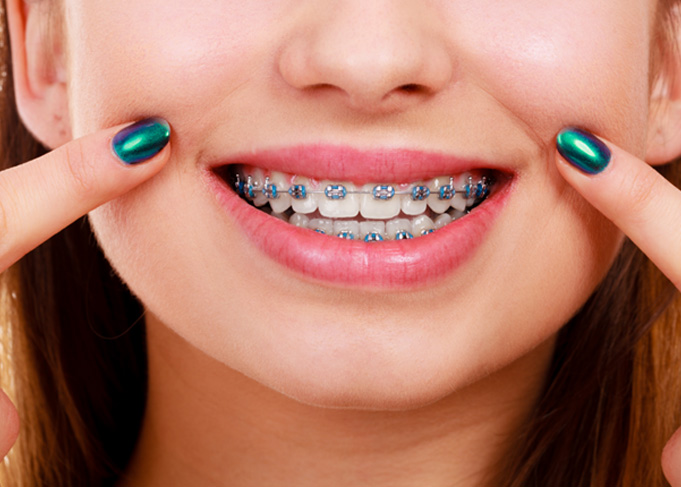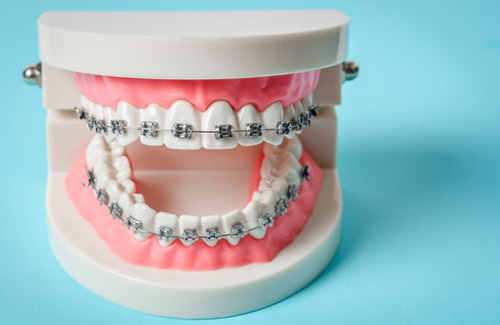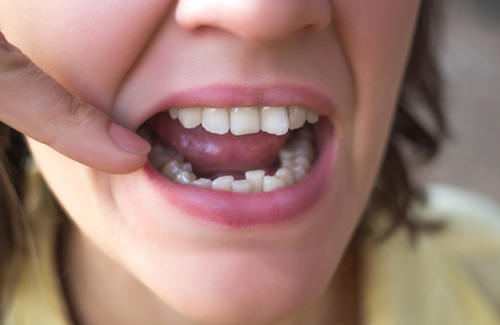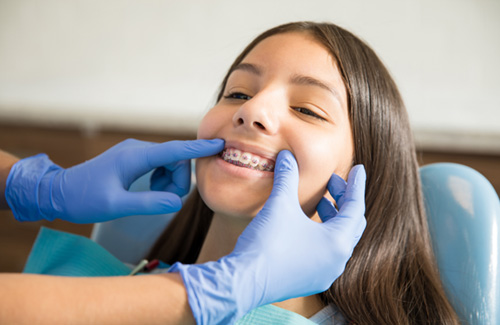Traditional Braces – West Jordan, UT
A Sure Way to Straighten Your Smile

These days, more and more patients than ever before are turning toward traditional braces to address orthodontic issues that have been detracting from their smile’s beauty and their overall quality of life. Our team understands just how impactful these sorts of problems can be, which is why we’re dedicated to providing treatments like braces that can tackle orthodontic issues of virtually all natures. Keep reading to learn a little more about how traditional braces can help you achieve all of your orthodontic goals, or feel free to call us today to kick off your orthodontic journey!
Why Choose Frandsen Dental of West Jordan for Traditional Braces?
- Patients of All Ages Proudly Welcome
- Fully Personalized Treatment Plans
- Insurance Accepted & Financing Options
How Do Traditional Braces Work?

Your teeth, although they may seem mostly stationary, are not totally immobile. They’re actually attached to the jawbone with the help of tiny ligaments; this allows them to be moved, both naturally and with the assistance of orthodontics. Traditional braces can safely facilitate this movement; these metal brackets and wires encourage your teeth to move by using gentle, sustained pressure. Over the course of several months, these micromovements shift your teeth into healthier, straighter positions. Sometimes, additional accessories and attachments are needed, including elastics and retainers.
What Orthodontic Issues Can Braces Fix?

During your consultation, we’ll assess your smile and determine if braces are a viable means of addressing your orthodontic issues. That said, they’re normally quite effective when it comes to a number of common problems, including:
Bite Misalignment
Bite issues such as overbites, underbites, crossbites, or even open bites can cause trouble when it comes to eating and speaking, as well as lead to serious dental problems like including TMJ disorder, or even bruxism (teeth grinding). Braces are perhaps the best means of correcting these bite issues and improving chewing capabilities and speech patterns.
Crowded & Crooked Teeth
It’s possible that there may not be enough room inside your mouth for your teeth at first, causing them to come in crooked and/or overlapping. This is not purely an aesthetic issue, though – having crowded teeth means cavity-causing bacteria have an easier time staying hidden. Braces are often used to target these specific issues, ensuring every one of your teeth has enough room and you’re able to keep them all in great shape.
Gapped Teeth
It can be frustrating to deal with gaps between any of your teeth, but especially those that are visible when you smile. Not only do these gaps detract from your smile’s beauty, but they also heighten the risks of issues like cavities and gum disease. Braces can exert the precise pressure needed to close these gaps.
Caring for Your Braces

A problem with your braces, such as a broken wire or bracket, can cause delays, but an oral health issue can just as easily cause a setback. To properly care for your braces, consider these tips:
- Follow your dietary restrictions closely; particularly hard, crunchy, chewy, or sticky items can unexpectedly harm your braces.
- Prioritize attending your routine check-ins; these adjustments and quick inspections are crucial for keeping your treatment timeline right on track.
- Practice sports safety by wearing a mouthguard when you’re participating.
- Be sure that you’re brushing and flossing after every meal, if possible – food debris can quite easily become trapped under your brackets and wires, which can lead to bacteria forming plaque.
Traditional Braces FAQs
What Can You Not Eat with Traditional Braces?
In an effort to prevent you from experiencing an orthodontic emergency and falling off track with your treatment plan, we will provide you with a list of dietary restrictions. Some foods include popcorn, caramel-filled candies, whole apples, hard pretzels, and croutons. Instead, we recommend eating mostly nutrient-dense foods that are softer in consistency, including plain yogurt, cooked carrots, cottage cheese, oatmeal, and bananas.
Do Traditional Braces Hurt?
Toward the beginning of your orthodontic treatment, it’s normal to experience soreness from the movement of your teeth. Fortunately, there are a few ways you can alleviate symptoms like these, including eating extremely soft foods, using a cold compress, rinsing with warm saltwater, and taking OTC pain medication as directed.
Tip: If your discomfort is stemming from the brackets or wires instead of the movement of your teeth, then use some dental wax to cover it!
Am I Too Old to Get Braces?
If you are interested in getting braces in West Jordan, but you’re worried that you’re “too old,” we have good news: age isn’t what determines if someone is a candidate. So, don’t hesitate to schedule a consultation with us! After we’ve completed a comprehensive oral exam, reviewed your dental history, and discussed your smile goals, we can review all of your orthodontic treatment options, including traditional braces.
What Happens After You Get Your Braces Off?
After we take your braces off, we will take impressions of your teeth so a custom retainer can be made. This is crucial because, without this orthodontic appliance, your teeth can move out of alignment. The good news is that most patients only need to wear theirs at night. Plus, there are some retainers that closely resemble Invisalign aligners, making them basically invisible.
How Long Do Traditional Braces Take?
There are several factors that impact the length of your teeth-straightening journey with traditional braces, including your age, the complexity of your case, and how well you follow the treatment guidelines provided. With all of that said, we can provide you with an estimate at your consultation. We can also discuss what to do to avoid frustrating delays, like prioritizing your adjustment appointments and abiding by the dietary restrictions.
Can You Drink Coffee with Traditional Braces?
You can. However, you need to keep in mind that frequent consumption of dark-colored beverages like this can cause your teeth to discolor. So, it’s best to drink yours the “smile-friendly” way (a.k.a. use a straw, don’t add sugar, and rinse your mouth thoroughly with water when you’re done).
How Can I Reduce the Cost of Traditional Braces?
If you’re concerned about the cost of traditional braces, we have good news: there are several ways you can make it more affordable, starting with dental insurance. We also offer our own in-house membership plan, which comes with a significant discount on treatments completed at our office, and we welcome flexible financing with Cherry. If you’d like more details on any of these financial solutions, let us know!
